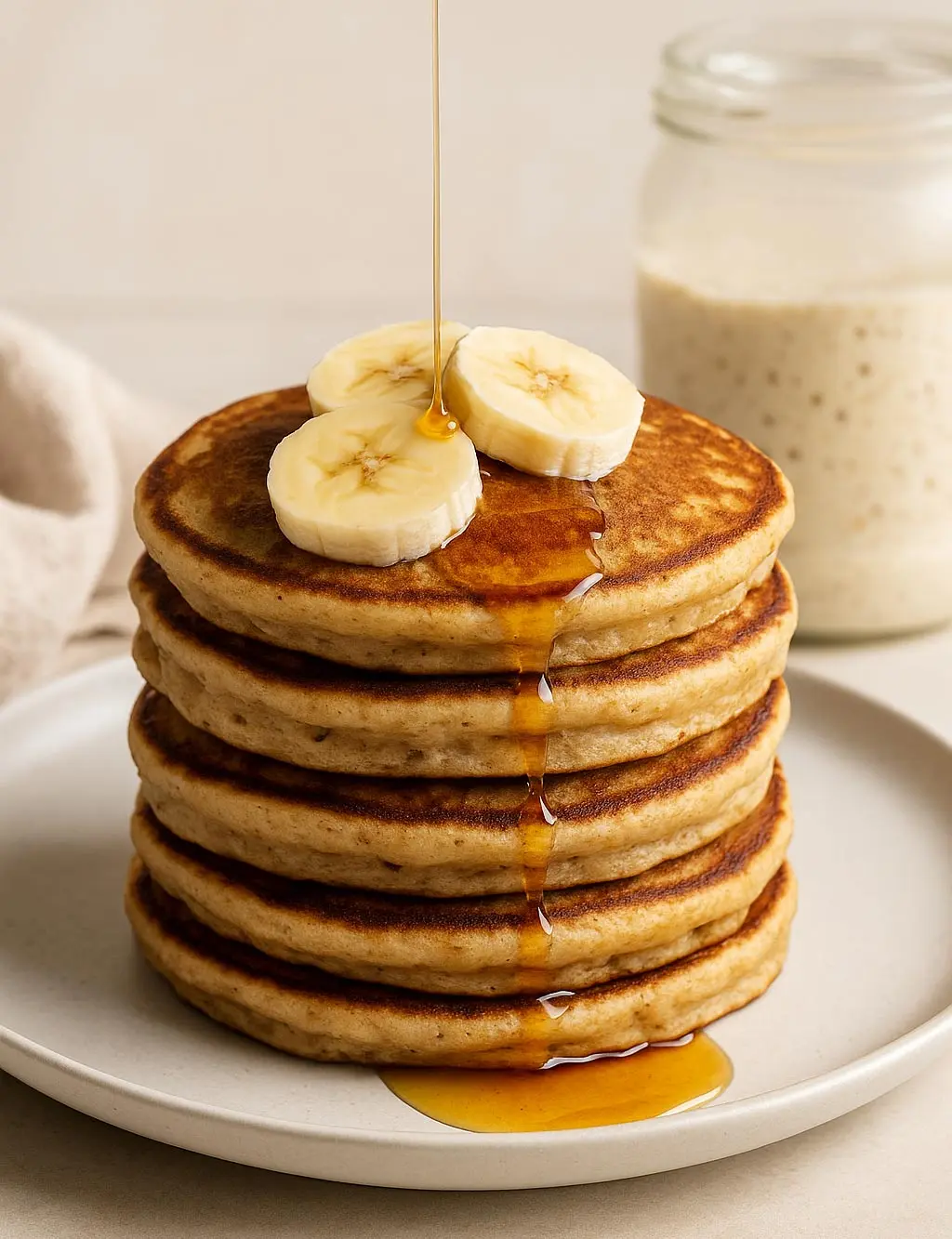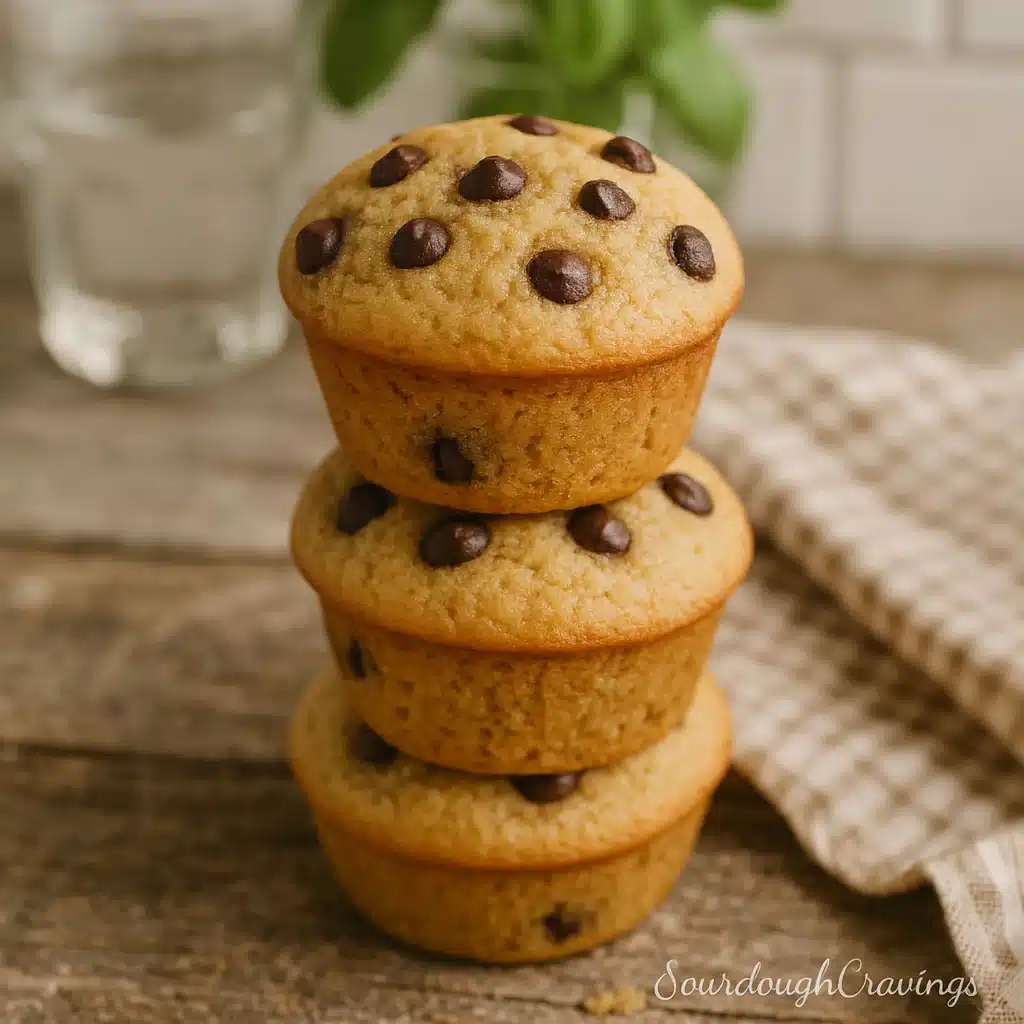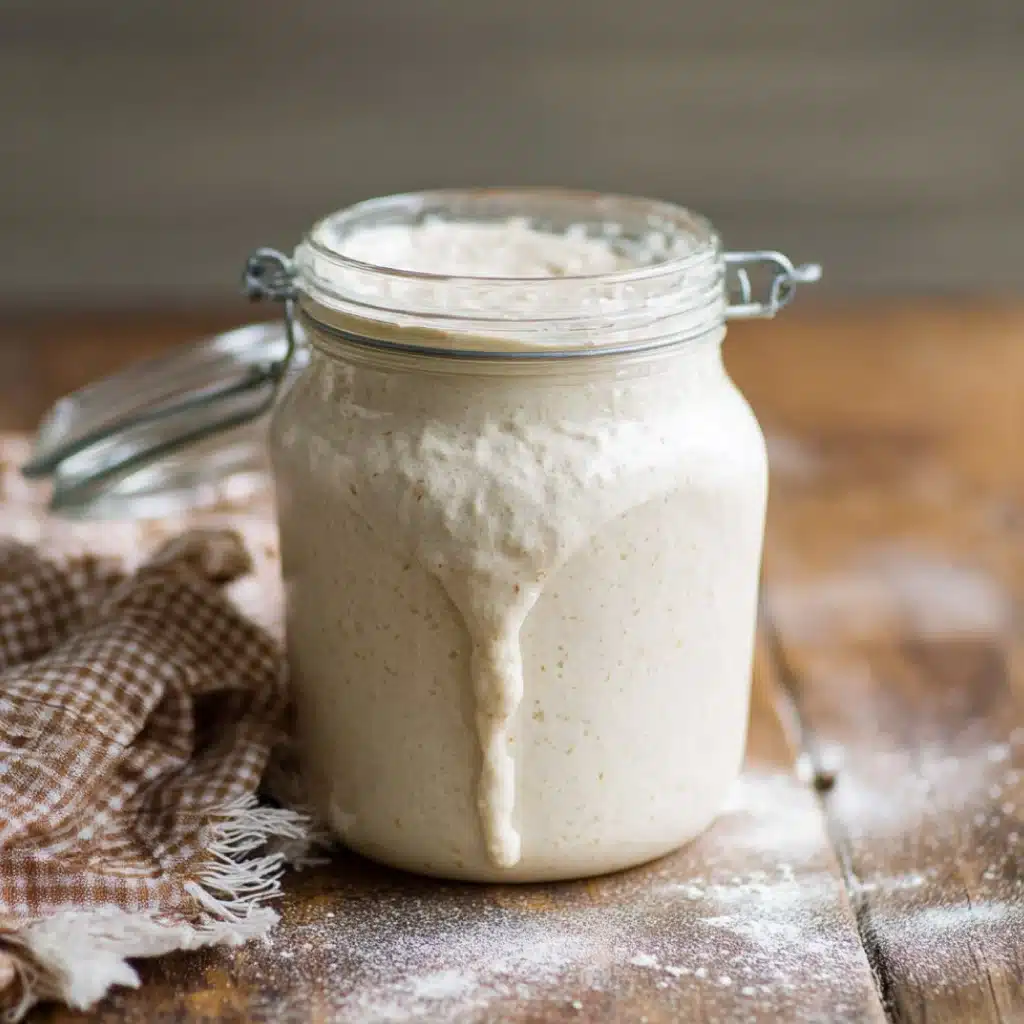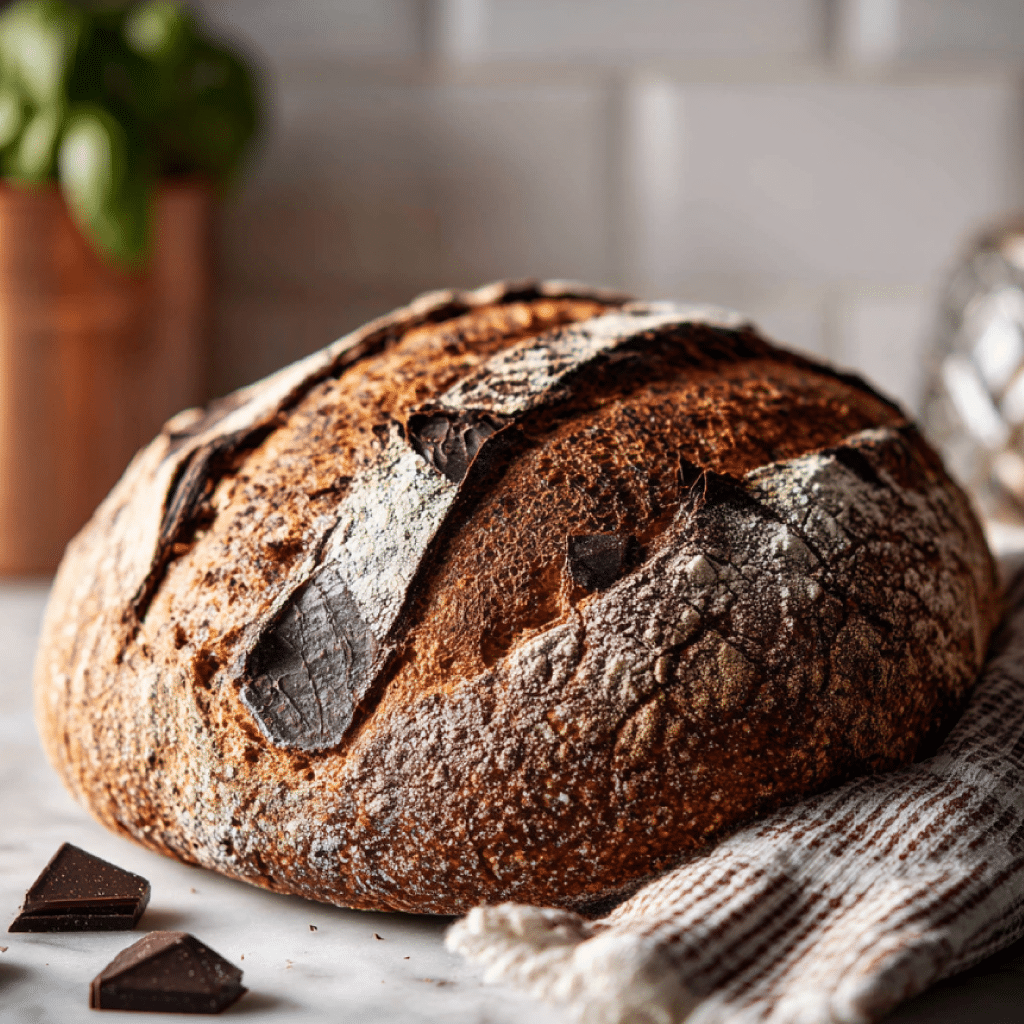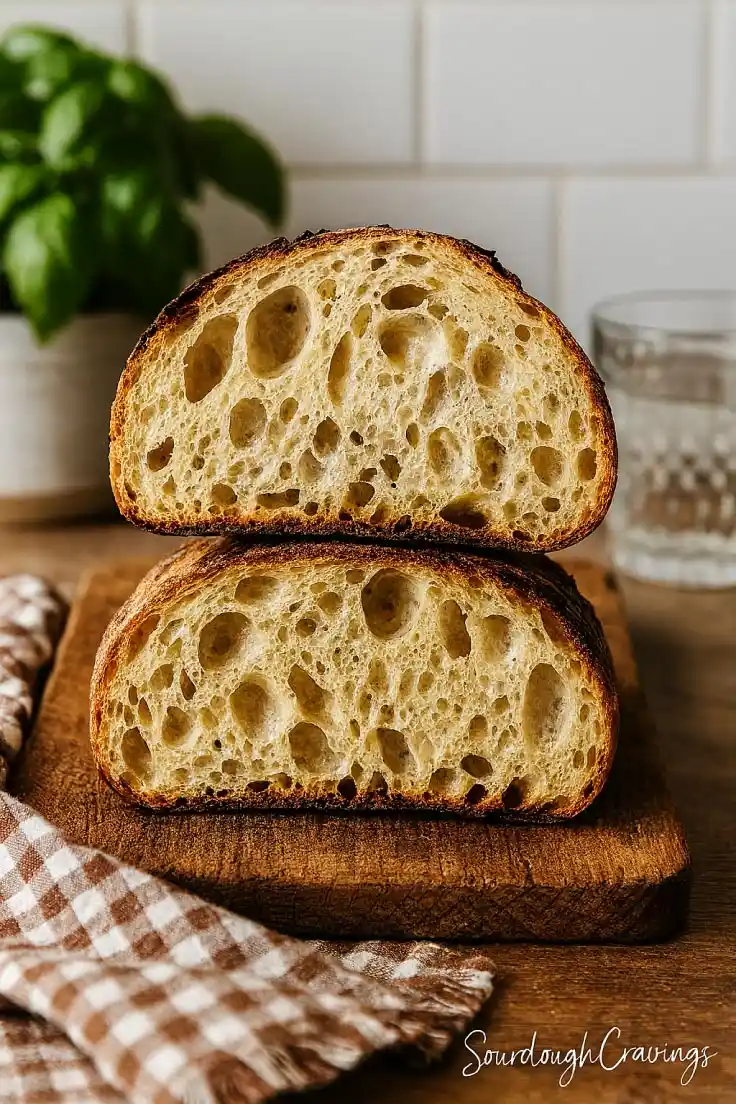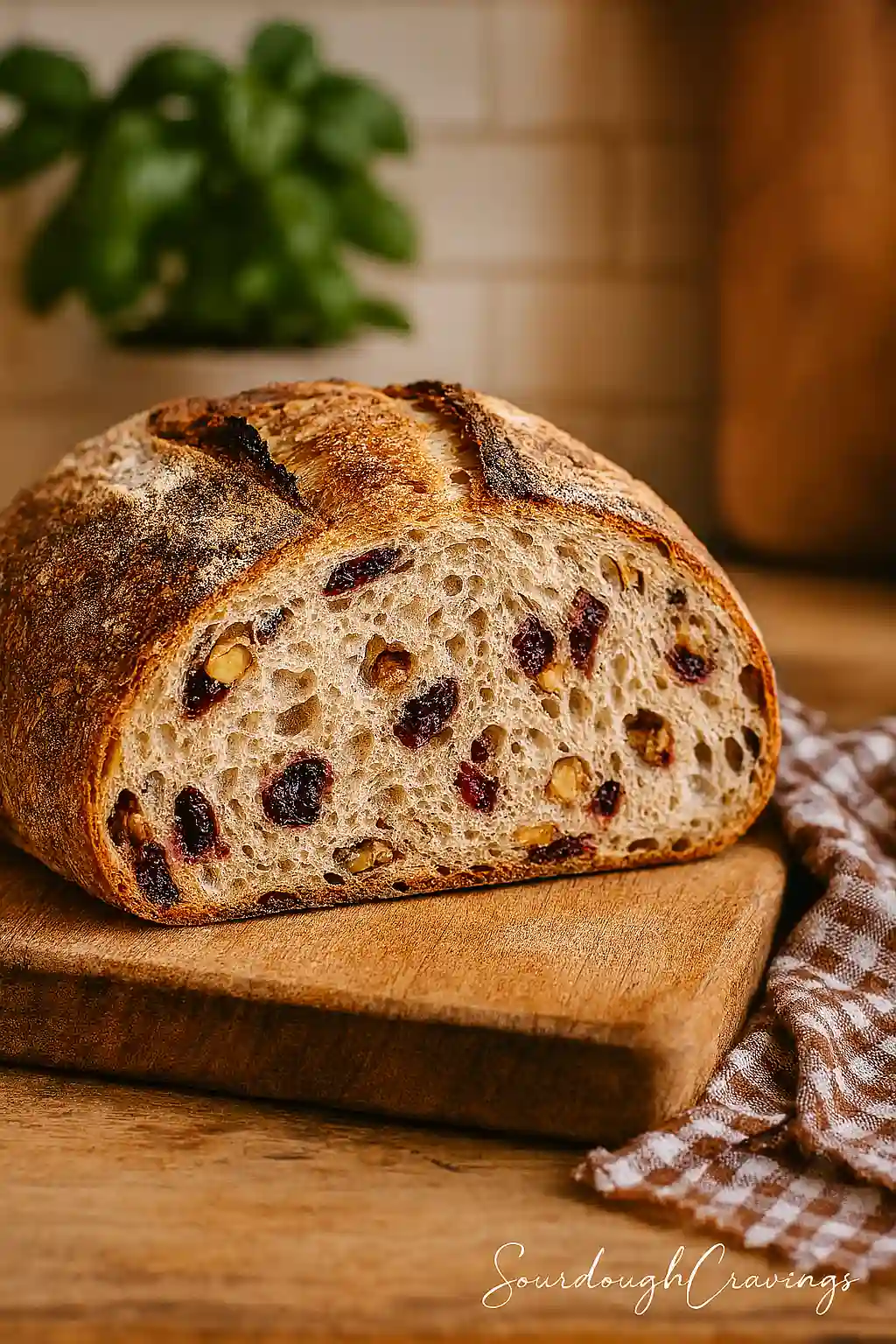The first time I opened my jar of sourdough discard, I nearly dropped it. A wave of sharp, tangy air hit me, and I thought, something’s wrong. If you’ve ever asked yourself why does sourdough discard smell?, you’re not alone. Every home baker runs into this moment.
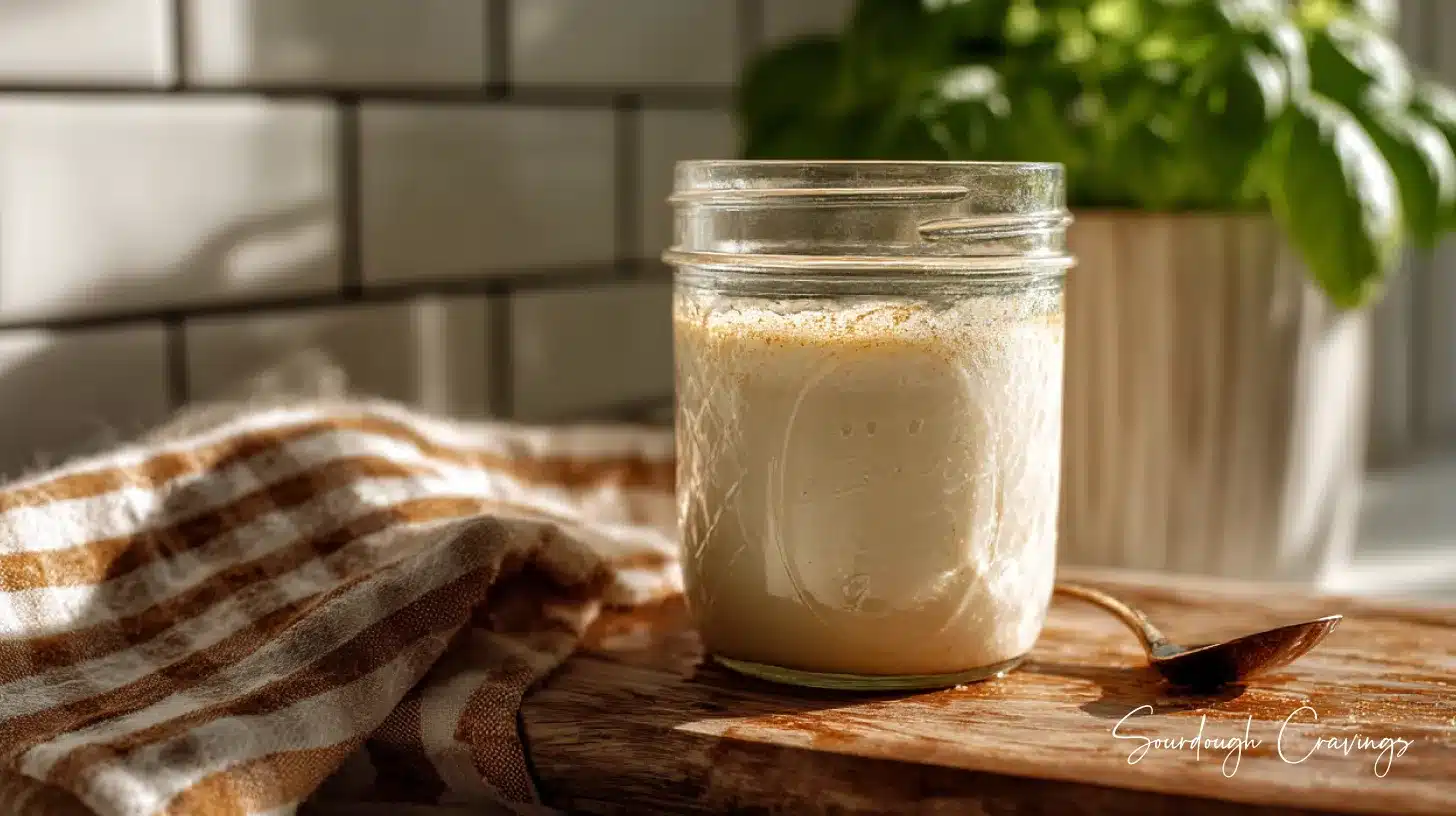
Sourdough discard is simply unfed starter, and like all living cultures, it shifts as it rests. Some days it smells pleasantly sour, almost like apple cider vinegar. Other times, it leans boozy or sharp because of a liquid called hooch that forms on top. And yes, sometimes the smell can drift into territory that makes you question whether it’s still safe to use.
Smell is the most reliable clue to what’s happening inside your jar. By paying attention, you can tell when your sourdough discard is perfectly fine, when it needs a little refresh, and when it’s time to let it go.
If you’re new to discard overall, I recommend starting with my complete Sourdough Discard Guide for the bigger picture. For now, let’s dig into the science of those aromas — and finally answer the question: why does sourdough discard smell?
For deeper starter science, Maurizio Leo at The Perfect Loaf also shares helpful insight into how bacteria and yeast shape smell and flavor.
Table of Contents
Understanding Why Sourdough Discard Smells
When bakers first wonder why does sourdough discard smell?, the answer always comes back to fermentation. Your discard is alive with wild yeast and bacteria, and those little organisms never stop working. Even after you’ve set your starter aside, they continue breaking down flour and releasing gases, acids, and alcohols — each of which carries its own distinct smell.
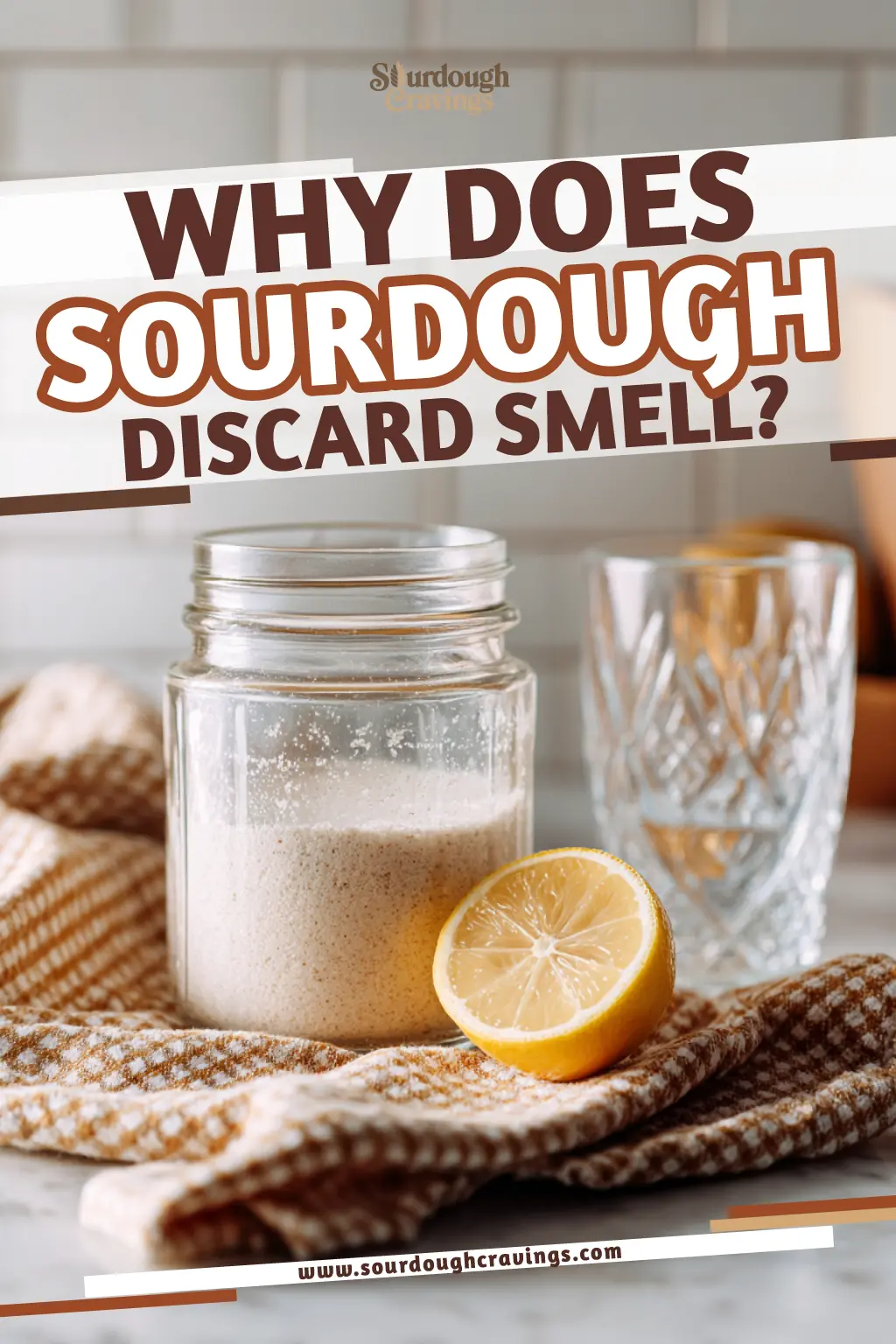
The first layer of scent comes from lactic acid bacteria, the same friendly microbes found in yogurt and kefir. They’re responsible for the tangy, sour notes that are perfectly normal in discard. The second layer comes from wild yeast, which produces alcohol as it eats sugars in the flour. When that alcohol separates into a liquid called hooch, you’ll notice a stronger boozy or sharp smell.
As discard ages, these aromas become more concentrated. That’s why a jar that smelled pleasantly sour on day three might smell sharper or even off by day ten. It’s not automatically a bad sign — but it’s your starter’s way of telling you it’s hungry and out of balance.
Fermentation is a living process, and smell is its most obvious signal. Understanding this helps you read the health of your discard without second-guessing. Later, we’ll break down which smells are safe and which mean it’s time to toss.
Common Smells & What They Mean
If you’re standing at the counter asking yourself why does sourdough discard smell?, it helps to break down the most common aromas. Each smell tells you something about the state of your discard — whether it’s fresh, still usable, or time to let it go.
Tangy or Vinegary Smell
This is the most common smell bakers notice, and it’s a good sign. Tangy, vinegar-like notes come from lactic acid bacteria, the same kind you find in yogurt or pickles. It means your discard is alive and active, producing natural acids as it ferments.
Think of it like a sour candy — sharp but not unpleasant. If your discard smells tangy, it’s safe to use in recipes like crackers, pancakes, or muffins. This is usually the smell you’ll encounter within the first few days of storage.
Boozy or Alcohol Smell
If your discard smells boozy, sharp, or like beer, it’s because of hooch — the liquid alcohol that separates and floats on top when the yeast runs out of food. It can look gray or brown, and it smells exactly like what it is: alcohol.
This smell is common if your discard has been sitting for a week or longer without a refresh. It’s still safe to use, but it’s a sign your starter is hungry. You can stir the hooch back in for extra tang, or pour it off if you prefer a milder flavor.
This ties directly to the question why does sourdough discard smell? — because yeast is always producing alcohol, especially when neglected.
Rotten or Putrid Smell
Here’s where caution kicks in. If your discard smells rotten, putrid, or makes you recoil, it’s no longer safe. A rotten smell suggests harmful bacteria have taken over, outcompeting the friendly yeast and lactic acid.
This smell is unmistakable — it’s closer to garbage than to sourdough. If you encounter it, toss the discard, clean the jar thoroughly, and refresh your starter with a healthy portion of flour and water.
Rotten smells are the answer to why does sourdough discard smell? in the most concerning way: it’s gone bad.
Ammonia or Nail Polish Remover Smell
Sometimes discard develops a sharp, chemical-like smell — almost like ammonia or nail polish remover. This is caused by over-fermentation, when the yeast and bacteria have consumed all available food and start producing stress byproducts.
It doesn’t always mean your discard is unsafe, but it does mean it’s out of balance and in need of care. Refreshing your starter with fresh flour and water usually solves the problem. If the smell persists after a few feedings, it’s best to toss and rebuild.
Earthy or Floury Smell
Less common, but worth noting: sometimes discard smells more like wet flour, clay, or even earthy soil. This usually happens in the early stages of a new starter or when using whole grain flours like rye. It’s not a problem — just the flour speaking through fermentation.
Sourdough Discard Smell Decoder
Not sure why your sourdough discard smells? Choose the scent below to learn what it means.
Why These Smells Matter
Each of these smells is your discard’s way of communicating. Pleasantly tangy or mildly boozy? Safe. Rotten or ammonia-like? Time to intervene. Once you learn to recognize the range of aromas, you’ll stop second-guessing and start trusting your senses.
When to Worry About Discard Smell
There’s a difference between a jar that smells sharp but usable and one that’s truly gone bad. When bakers ask why does sourdough discard smell?, sometimes the answer is reassuring — and sometimes it’s your sign to toss it and start fresh. Here are the red flags worth paying attention to.
Mold Plus an Off Smell
If you ever lift the lid and notice fuzzy patches in green, pink, or black combined with a foul odor, it’s time to let go. Mold paired with a bad smell means your discard is no longer safe to keep around. Even if the top looks scoopable, mold spreads invisibly, and the safest move is always to throw it away.
This connects naturally to the bigger conversation in my Troubleshooting Discard: Mold & Hooch Guide (Coming Soon).
Strange Colors with Strong Odors
Occasionally, discard shifts in color — pink streaks, orange tints, or unusual patches — and the smell turns from tangy to unpleasant. This is one of the clearest signals that spoilage has set in. Healthy discard might look gray or develop hooch, but bright or unusual colors paired with bad smells always mean it’s time to toss.
For a deeper look at shelf life and safety, see Can Discard Go Bad? Signs and Safety Tips (Coming Soon).
Chemical or Ammonia-Like Notes
Every baker eventually opens their jar to a smell that’s more chemical than sour — like nail polish remover or ammonia. This usually means your discard has been sitting too long and is out of balance. Sometimes a feeding can reset it, but if the sharpness lingers after refreshment, it’s better to start over with a fresh jar.
If you’ve ever seen hooch on top and wondered how it connects to these stronger smells, I’ll cover that in What Is Sourdough Hooch? (Coming Soon).
When the Smell Makes You Pull Back
Here’s the test I use in my own kitchen: if I open the jar and instinctively lean away, that’s my answer. Sourdough discard should smell sour or tangy, maybe boozy, but it should never smell rotten or gag-inducing. In those moments, I don’t overthink it — I toss it, wash the jar, and get back to baking with a refreshed culture.
For a big-picture overview of how to judge discard in different situations, my Sourdough Discard Guide is a great place to start.
Why Trust Smell?
At the end of the day, smell is the most powerful clue we have. Asking why does sourdough discard smell? is really about learning to trust your senses. Pleasantly sour, tangy, or lightly boozy is fine. Moldy, rotten, or chemical is not. Once you tune in, you’ll know the difference without second-guessing.
How to Fix Smelly Discard
If you’ve ever stood over the jar and wondered why does sourdough discard smell?, the good news is that not every strong odor means you have to throw it out. Many times, the smell is just your discard asking for a little care. Here are the simplest ways to bring it back into balance.
Stir In or Pour Off the Hooch
That thin layer of liquid alcohol on top — called hooch — is one of the most common reasons discard smells sharp or boozy. It’s safe, but it can throw off the aroma. You have two options: stir it back in for more tang or pour it off for a milder scent.
👉 If hooch confuses you, I explain it in detail in What Is Sourdough Hooch? (Coming Soon) and also cover how to manage it in How to Get Rid of Discard Hooch (Coming Soon).
Refresh with a Feeding
Sometimes smelly discard is just hungry. A fresh feeding of flour and water resets the balance, tones down sharp odors, and keeps the good bacteria happy. If your discard smells overly acidic or chemical, give it a refresh and let it ferment for a few hours before deciding to keep or toss it.
👉 Step-by-step help is in How to Refresh Old Sourdough Discard (Coming Soon) and my Sourdough Discard Feeding Schedule (Coming Soon).
Adjust Storage
How and where you store discard makes a big difference. If it sits too long on the counter, odors develop quickly. The fridge slows fermentation, keeping discard usable longer, while the freezer stops fermentation completely. If your discard keeps smelling off sooner than you’d like, try changing your storage method.
I cover this fully in How to Store Sourdough Discard (Coming Soon) and compare methods in Refrigerator vs Freezer: Best Discard Storage (Coming Soon).
Keep Portions Small
One overlooked trick: don’t let discard pile up endlessly. Smaller amounts mean fewer chances for it to sour too deeply. If you bake less often, keep your starter lean and freeze or compost extra discard instead of letting it build up.
Learn safe ways to reduce excess in Can You Compost Discard? (Coming Soon) or give it a second life in the garden with How to Make Discard Liquid Gold Fertilizer (Coming Soon).
Why Fixing Smell Matters
A smelly jar doesn’t have to end your baking week. In most cases, the answer to why does sourdough discard smell? is simple: it’s either overfed, underfed, or stored too long. Small changes — a feeding, better storage, or managing hooch — are usually enough to keep your discard usable and safe.
Preventing Bad Smells in the Future
After a few funky jars of my own, I started asking not just why does sourdough discard smell?, but also how can I keep it smelling fresh in the first place? The truth is, most odor problems come from a mix of time, temperature, and neglect. With a little planning, you can keep your discard in great shape — and keep your kitchen smelling inviting instead of sour.
Store It the Right Way
Where you keep your discard makes all the difference. On the counter, it ferments quickly and will smell tangy within a day or two. In the fridge, the process slows dramatically, giving you up to two weeks before it turns unpleasant. For anything longer, freezing is your best bet.
The USDA notes that food stored cold slows microbial growth significantly, but nothing lasts forever — even in the fridge (USDA Food Safety Guidelines). If you’re unsure how long is too long, I’ve shared a full breakdown in my Sourdough Discard Guide.
Keep Portions Small
I learned the hard way that letting discard pile up leads to overpowering smells. Instead, I only keep what I know I’ll use in a week or two. Smaller jars mean fresher discard and less stress about waste. If you don’t bake often, it’s better to save a few spoonfuls and compost or freeze the rest.
(If you’re curious about using leftovers in your garden, the US EPA guide to composting at home is a fantastic resource.)
Feed on a Regular Rhythm
If you keep your starter on the counter, think of feeding as its daily meal. Skipping feedings is one of the fastest ways to end up asking why does sourdough discard smell? Consistency keeps the yeast and bacteria balanced, so the jar stays tangy instead of veering into harsh, boozy, or rotten territory.
When I struggled to remember, I set reminders on my phone. Now it’s just part of my morning rhythm — feed the kid, feed the starter, and enjoy the quiet moment.
Choose the Right Container
Finally, don’t overlook the jar itself. A clean, breathable container helps prevent off-smells by reducing trapped gasses and contamination. I swap mine out regularly and give it a good wash with hot, soapy water. It seems like a tiny detail, but fresh air circulation makes a noticeable difference.
Building Confidence in Your Kitchen
The longer you bake, the easier it gets to recognize what’s normal. Instead of panicking over why does sourdough discard smell?, you’ll start to see it as a helpful guide. A little tang is fine, a splash of hooch is manageable, and strong off-odors are your cue to refresh or start over.
For a deeper dive into long-term storage, preventing waste, and my favorite backup routines, I’ve laid everything out step by step in the Sourdough Discard Guide.
FAQs About Sourdough Discard Smells
When I first started baking, I kept a running list of questions on sticky notes next to my starter jar. Here are the ones I hear most often from new bakers who ask why does sourdough discard smell?
Why does sourdough discard smell sour?
That sharp, vinegar-like smell comes from lactic acid bacteria doing their job. It’s normal and safe. In fact, it’s the same type of bacteria that give yogurt and sauerkraut their tang.
Why does sourdough discard smell like alcohol?
That boozy smell is hooch — a natural byproduct when yeast runs out of food. It’s safe, though you can stir it in for stronger flavor or pour it off if you want something milder. If you’re unsure how to handle hooch, I go into more detail in my Sourdough Discard Guide.
Why does sourdough discard smell rotten?
A rotten, garbage-like smell means unwanted bacteria have taken over. Trust your senses: if it smells like trash, it belongs in the trash. Food safety experts like the USDA emphasize that smell is one of the most important spoilage indicators.
Why does sourdough discard smell like nail polish remover?
That chemical edge is usually a sign of over-fermentation. The yeast and bacteria have exhausted their food and started producing sharp byproducts. A refresh often fixes it, but if the smell lingers, it’s best to start with fresh discard.
Can sourdough discard smell different depending on flour?
Yes! Whole wheat and rye flours often create earthier, stronger aromas than all-purpose flour. They have more natural minerals and microbes, which influence smell as fermentation develops.
Is sourdough discard safe if it smells strong but looks normal?
Most of the time, yes — as long as the smell is tangy, sour, or boozy. If the smell is rotten, putrid, or makes you gag, it’s not safe. When in doubt, toss it. For a step-by-step breakdown of safety checks, see the Sourdough Discard Guide.
How long before sourdough discard starts to smell bad?
At room temperature, you may notice stronger odors within a day or two. In the fridge, discard usually lasts one to two weeks before smells become unpleasant. Freezing will extend shelf life for months. The FDA’s refrigeration guidelines confirm that cooler temps always slow microbial activity.
Can sourdough discard smell bad but still be safe?
Sometimes a strong tang or boozy smell is still safe. But if the odor crosses into rotten, chemical, or moldy territory, don’t risk it. Smell is one of the simplest tools we have for food safety.
Why does sourdough discard smell different every time I open the jar?
Because fermentation is always changing. Temperature, flour type, feeding rhythm, and storage all influence what you smell. Once you understand the patterns, you’ll stop asking why does sourdough discard smell? and start recognizing it as part of your discard’s unique rhythm.
Key Takeaways
If you’ve ever asked yourself why does sourdough discard smell?, the answer is usually simple: it’s part of fermentation.
Here’s what to remember:
- Tangy or sour notes are normal and safe — they signal healthy bacteria at work.
- A boozy or beer-like smell means hooch has formed; it’s still safe but needs attention.
- Rotten, moldy, or chemical odors are clear signs to toss your discard.
- Storage, feeding rhythm, and container choice all play big roles in preventing off-smells.
- Trust your nose. If it smells unpleasant enough to make you pull back, it doesn’t belong in your food.
With a little observation, smells stop being scary and become a tool to guide your baking.
Conclusion
The journey of baking with sourdough is full of sensory learning, and smell is often the first clue that something has shifted. Instead of panicking when you notice a strong odor, pause and ask: is it tangy, boozy, or truly rotten? That simple check helps you decide whether to keep baking or refresh your jar.
If you’re ready to go deeper into using, storing, and troubleshooting discard, you’ll find everything laid out step by step in my Sourdough Discard Guide. It’s the best place to start if you want to feel confident and stop second-guessing your discard.
Remember: every baker has opened a jar and wondered why does sourdough discard smell? With a bit of practice, you’ll not only recognize the difference between safe and unsafe, but you’ll also feel empowered to prevent problems before they begin. That’s the beauty of baking with sourdough — it teaches us to trust our senses as much as our recipes.

